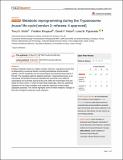Files in this item
Metabolic reprogramming during the Trypanosoma brucei life cycle
Item metadata
| dc.contributor.author | Smith, Terry K. | |
| dc.contributor.author | Bringaud, Frédéric | |
| dc.contributor.author | Nolan, Derek P. | |
| dc.contributor.author | Figueiredo, Luisa M. | |
| dc.date.accessioned | 2017-07-11T14:30:09Z | |
| dc.date.available | 2017-07-11T14:30:09Z | |
| dc.date.issued | 2017-05-18 | |
| dc.identifier | 250484202 | |
| dc.identifier | 2656b2fb-dde9-43e4-a7f9-5273aa73e2f7 | |
| dc.identifier | 85024481213 | |
| dc.identifier.citation | Smith , T K , Bringaud , F , Nolan , D P & Figueiredo , L M 2017 , ' Metabolic reprogramming during the Trypanosoma brucei life cycle ' , F1000Research , vol. 6 , 683 . https://doi.org/10.12688/f1000research.10342.2 | en |
| dc.identifier.issn | 2046-1402 | |
| dc.identifier.other | PubMedCentral: 5461901 | |
| dc.identifier.uri | https://hdl.handle.net/10023/11184 | |
| dc.description | TKS is supported by the Wellcome Trust, the Biotechnology and Biological Sciences Research Council, the Engineering and Physical Sciences Research Council, the Medical Research Council (MR/M020118/1) and the European Community Seventh Framework Programme under grant agreement 602773 (Project KINDRED). FB is supported by the Centre National de la Recherche Scientifique (CNRS), the Université de Bordeaux, the Agence Nationale de la Recherche (ANR) through the GLYCONOV grant (ANR-15-CE15-0025-01) of the ‘Générique’ 2015 call and the Laboratoire d’Excellence (LabEx) ParaFrap (grant ANR-11-LABX-0024). DPN is supported by the Wellcome Trust and Science Foundation Ireland. LMF is supported by the Howard Hughes Medical Institute (55007419) and the Fundação para a Ciência e a Tecnologia (FCT) (PTDC/BIM-MET/4471/2014). | en |
| dc.description.abstract | Cellular metabolic activity is a highly complex, dynamic, regulated process that is influenced by numerous factors, including extracellular environmental signals, nutrient availability and the physiological and developmental status of the cell. The causative agent of sleeping sickness, Trypanosoma brucei, is an exclusively extracellular protozoan parasite that encounters very different extracellular environments during its life cycle within the mammalian host and tsetse fly insect vector. In order to meet these challenges, there are significant alterations in the major energetic and metabolic pathways of these highly adaptable parasites. This review highlights some of these metabolic changes in this early divergent eukaryotic model organism. | |
| dc.format.extent | 1635439 | |
| dc.language.iso | eng | |
| dc.relation.ispartof | F1000Research | en |
| dc.subject | Trypanosoma brucei | en |
| dc.subject | Metabolism | en |
| dc.subject | Adaptations | en |
| dc.subject | QH301 Biology | en |
| dc.subject | SDG 3 - Good Health and Well-being | en |
| dc.subject.lcc | QH301 | en |
| dc.title | Metabolic reprogramming during the Trypanosoma brucei life cycle | en |
| dc.type | Journal item | en |
| dc.contributor.sponsor | European Commission | en |
| dc.contributor.sponsor | Medical Research Council | en |
| dc.contributor.sponsor | The Wellcome Trust | en |
| dc.contributor.institution | University of St Andrews. School of Biology | en |
| dc.contributor.institution | University of St Andrews. Biomedical Sciences Research Complex | en |
| dc.identifier.doi | 10.12688/f1000research.10342.2 | |
| dc.description.status | Peer reviewed | en |
| dc.identifier.url | https://f1000research.com/articles/6-683/v2 | en |
| dc.identifier.grantnumber | 602773 | en |
| dc.identifier.grantnumber | MR/M020118/1 | en |
| dc.identifier.grantnumber | 093228/Z/10/Z | en |
This item appears in the following Collection(s)
Items in the St Andrews Research Repository are protected by copyright, with all rights reserved, unless otherwise indicated.

